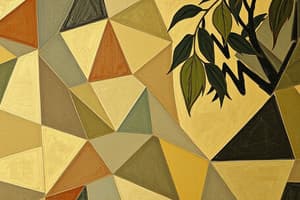Podcast
Questions and Answers
What real-world scenario requires accurate calculations of volume to assess the quality of concrete placed in complex geometries?
What real-world scenario requires accurate calculations of volume to assess the quality of concrete placed in complex geometries?
- Agricultural planning
- Construction planning (correct)
- Land surveying
- Scientific studies
In land surveying, what might surveyors need to determine accurately when dealing with irregular figures?
In land surveying, what might surveyors need to determine accurately when dealing with irregular figures?
- The shared property boundary (correct)
- The crop yield
- The infrastructure design
- The soil composition
Why might farmers need to know the total area of a non-uniformly shaped plot?
Why might farmers need to know the total area of a non-uniformly shaped plot?
- To determine the number of neighboring farms
- To assess soil quality
- To plan crop yields effectively (correct)
- To predict weather patterns
What is a key consideration for engineers when designing infrastructure components like bridges and tunnels?
What is a key consideration for engineers when designing infrastructure components like bridges and tunnels?
Which field benefits from understanding how to find the area of irregular shapes according to the text?
Which field benefits from understanding how to find the area of irregular shapes according to the text?
What does the text suggest about technology's role in working with unconventional shapes?
What does the text suggest about technology's role in working with unconventional shapes?
Why are irregular figures challenging when it comes to measuring their areas?
Why are irregular figures challenging when it comes to measuring their areas?
Which of the following is NOT an example of an irregular figure?
Which of the following is NOT an example of an irregular figure?
In what real-life application would finding the area of irregular figures be crucial?
In what real-life application would finding the area of irregular figures be crucial?
Why do construction projects often involve working with irregular figures?
Why do construction projects often involve working with irregular figures?
Which characteristic makes calculating the area of irregular figures more complex than regular shapes?
Which characteristic makes calculating the area of irregular figures more complex than regular shapes?
What makes irregular figures more challenging than regular shapes in terms of calculating area?
What makes irregular figures more challenging than regular shapes in terms of calculating area?
Study Notes
Irregular Figures: Finding the Area of Unconventional Shapes
Irregular figures, also known as complex geometric shapes, are those that do not fit neatly into one of the standard classifications such as triangles, squares, circles, rectangles, and so forth. They can have any number of sides or vertices and can take many different forms, each with its own unique characteristics and challenges when it comes to measuring their areas. In this article, we will explore the concept of irregular figures and discuss some practical applications where these unconventional shapes show up in everyday life, particularly in the context of calculating their areas.
What Are Irregular Figures?
An irregular figure is simply a shape that does not fit easily into one of the standard categories. It could be a polygon with an odd number of sides (such as a pentagon), a shape with curved edges like a circle, or even something more abstract and organic, like an amoeba or a cloud. These figures may appear simple initially, but they become more complex when you start trying to calculate their areas without using predetermined formulas.
Real-Life Applications: When Irregular Figures Matter
There are numerous instances where dealing with irregular figures is necessary in daily life, from small tasks to large-scale projects. Some examples include:
Construction Projects
Building a house, road, bridge, or any other construction project often involves working with various shaped surfaces and volumes. For example, the foundation might be made from a trapezoidal soil pit with uneven ground levels. To properly assess the quality of concrete placed in these complex geometries, it's crucial to know how much material was poured. This requires accurate calculations of volume, which can involve quite a few irregular figures.
Land Surveying
Land surveying typically involves determining the boundaries of a property, which can entail dealing with irregular figures. For instance, if there's a boundary disputed between neighbors, surveyors must accurately measure the shared line. Sometimes, this boundary could be described as something like "the point at which three trees meet," meaning the surveyor would be required to determine the area enclosed by those three trunks and branches, which is indeed an irregular figure.
Agricultural Planning
Farmers and agricultural planners often need to account for crop yields based on the land area available. If the plot is not uniformly shaped, this means dealing with irregular figures. For instance, a farmer may plant a garden in a shape that resembles a triangle with trapezoids along the borders. In such cases, knowing the total area of the garden allows farmers to plan their resources, such as seeds, fertilizer, and irrigation systems, effectively.
Engineering Design
When designing infrastructure components like bridges, tunnels, or water pipes, engineers need to consider the cross-sectional shape of the structure. These shapes can be very complex, involving curves and angles that don't fit cleanly into standardized equations. Calculating the area of these structures helps them estimate the amount of material needed, ensuring structural integrity while minimizing costs.
In conclusion, understanding how to find the area of irregular shapes is essential in these and countless other real-world scenarios. In addition to application in construction planning, land surveying, agriculture management, and engineering design, irregular figures play significant roles in scientific studies, architectural blueprints, satellite imagery analysis, and many other fields. As technology advances, our ability to work with and understand these unconventional shapes will only grow stronger, opening new doors for creativity and innovation across industries.
Studying That Suits You
Use AI to generate personalized quizzes and flashcards to suit your learning preferences.
Description
Explore the concept of irregular figures and learn how to calculate their areas in various real-life applications such as construction projects, land surveying, agricultural planning, and engineering design. Discover the challenges and importance of measuring areas of unconventional shapes in different practical scenarios.




